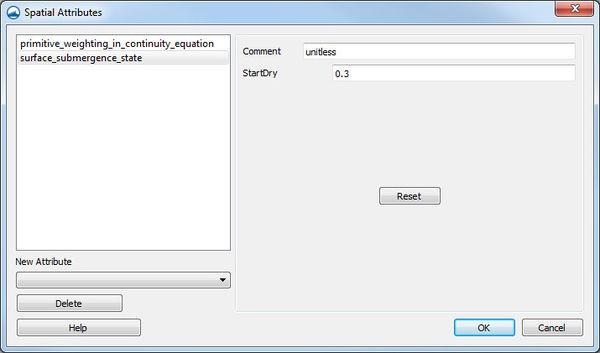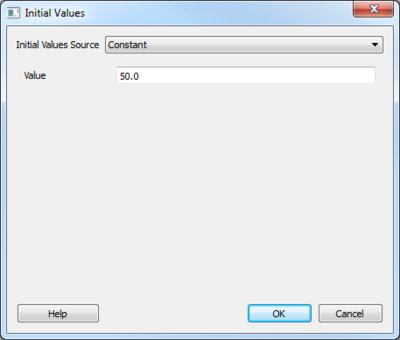SMS:ADCIRC Spatial Attributes
| This contains information about features no longer in use for the current release of SMS. The content may not apply to current versions. |
ADCIRC Nodal/Spatial Attributes
Spatial attributes (or nodal attributes) are parameters that can be applied to the entire domain of the simulation in the form of a dataset with values assigned to the nodes of the mesh. ADCIRC supports several such spatially varying input parameters and SMS (starting with version 11.0) includes functionality to assist defining, managing and editing these parameters. With each release of ADCIRC, the list of supported nodal attributes changes. There are several such attributes that are under development and are used by individuals in the ADCIRC community, but are not available in the release version. Therefore, the interface in SMS is a combination of specifically defined attributes to correspond with the standard parameters in ADCIRC and custom attributes to allow for customization and support of attributes not yet included in either the ADCIRC release or the standard list in the SMS interface.
Define these attributes in a the Spatial Attributes dialog under the ADCIRC menu. There are a number of predefined attributes that can be used or custom attributes can be defined. Here is a list of the predefined spatial attributes and a brief meaning of each.
In version 50 of ADCIRC, the following predefined nodal attributes are supported:
- Primitive weighting in continuity equation – Tau0
- Surface submergence state – StartDry
- Quadratic friction coefficient at sea floor – Fric
- Surface directional effective roughness length – z0Land
- Surface canopy coefficient – VCanopy
- Bridge pilings friction parameters – BK, BAlpha, BDelX, POAN
- Manning's n at sea floor – ManningsN
- Chezy friction coefficient at sea floor – ChezyFric
- Sea surface height above geoid – GeoidOffset
- Horizontal eddy viscosity – ESLM
- Wave_refraction_in_swan – SwanWaveRefrac (Supported in list of predefined attributes in SMS 11.2)
- Bottom_roughness_length – Z0b_var (Supported in list of predefined attributes in SMS 11.2)
- Average horizontal eddy viscosity in sea water wrt depth – ESLM
- Elemental_slope_limiter – elemental_slope_limiter_grad_max (Supported in list of predefined attributes in SMS 11.2)
- Advection_state – AdvectionState (Supported in list of predefined attributes in SMS 11.2)
Please visit the ADCIRC web site to learn more about the meaning of each of the spatial attributes listed above.
How to Use Spatial Nodal Attributes in a Simulation
Spatial nodal attributes are managed in the SMS using editable datasets. The creation and management of attributes is managed through the Spatial Attributes dialog. Access the Spatial Attributes dialog by selecting the ADCIRC | Spatial Attributes menu command.
Create a new spatial attribute by selecting the attribute name in the New Attribute combo-box. This will bring up the Spatial Attributes Initial Values dialog (discussed below).
The top left of the dialog has a list of the currently defined spatial attributes. The currently selected spatial attribute can be modified by the controls on the right side of the dialog or by editing specific dataset values by selecting the specific node(s) and entering a value. Each attribute has an associate comment. The comment is ignored by the model and is generally used for units information. The value below the comment is intended to represent the default value, or the value used the most in the dataset. Values at nodes that do not use the default value are written by the SMS to the fort.13 file as exceptions. The reset button will bring up the Spatial Attributes Initial Values dialog (discussed below).
Delete the current attribute by clicking on the Delete button. For each spatial attribute, SMS creates one or more datasets in the project explorer. However, these datasets cannot be deleted through the project explorer. They must be managed through the Spatial Attributes dialog.
Editing Spatial Attributes
To edit a spatial attribute, open the Spatial Attributes dialog. Select the spatial attribute that needs to be edited and select the Reset button.
Initial Values Dialog
The Initial Values dialog is used to setup the initial values for the dataset(s) used for the spatial attribute.
Every spatial attribute has the option of starting from a constant value or use the values from an existing dataset. In addition, some spatial attributes have an option to populate the spatial attribute based upon other data inside of SMS, using a rule, or using a utility similar to those provided on the ADCIRC websit to generate.
Populate Options
A spatial attribute consists of one or more datasets that can include unique values at each of the nodes in the mesh. This is potentially a lot of data and will generally not be specified manually. Two options exist for general population of the dataset. These include:
- Constant – Specifies a single value for all nodes. It is possible to later select one or more regions of nodes and assign a different value to these nodes using the scalar edit box at the top of the SMS interface.
- Dataset – Selects an existing dataset that is copied to the spatial attribute. Use any of the standard methods for defining the souce dataset including interpolation and the data calculator. Individual edits can still be made to nodes or regions of nodes by manually selecting them.
In addition to these two default methods of populating data sets, SMS supports some custom population approaches for specific attributes. These are described below.
Primitive weighting
The SMS includes a tool for populating the primitive weighting coefficient for each node based on the node spacing and the node depth. Specify a threshold for node spacing (Critical average node spacing) and depth (Critical depth). The defaults for these are 1750 m and 10 m respectively. Also specify a values for tau for three conditions including default (0.03), deep (0.005) and shallow (0.02).
If the average distance between a node and its neighbors is less than the critical value then tau0 for that node is set at the tau default. If the average distance between a node and its neighbors is greater than or equal to a critical spacing then tau0 for that node is assigned based on the depth using the deep or shallow value specified.
Quadratic, Manning N, and Chezy friction coefficients
The spatial attributes which reflect bottom friction "Chezy_friction_coefficient_at_sea_floor," "Mannings_n_at_sea_floor," and "quadratic_friction_coefficient_at_sea_floor" can be populated from NLCD land use data. Obtain NLCD geo-tiffs from the Multi-Resolution Land Characteristics Consortium website (www.mrlc.gov). Use the seamless server to download the data in the area of interest. To populate using this method, download the NLCD geo-tiff for the region of interest, load it into the SMS (creating an image), and convert it to a raster (right-click on the image). (Refer to the information of rasters for guidance).
When populating any of these spatial attributes, provide a roughness value for each land-use type and a default roughness value that will be used in areas of the raster that are NULL or outside the bounds of the raster.
The SMS will extract values from all visible raster objects (turned on in the project explorer). For each node in the mesh, the "area of influence" is computed for the node. The area of influence is a polygon that represents the area of the mesh around a node. This is computed as the area encompassing the node and half the distance to each of his neighboring nodes. All of the raster values within the area of influence are extracted from the visible raster objects. A composite roughness value is computed taking a weighted average of all the raster values. If the area of the extracted values is less then the area of influence around the node (because we passed the extent of the raster objects or encountered null values), the default value is used to compute the composite n using the area not represented in the values.
Surface directional effective roughness
The surface directional effective roughness length composes the contributing vegetation types associated with each of the 12 directions (30 degrees each) around each node in a mesh and assigns the 12 characteristic or composite reduction values to the datasets for the node.
The SMS includes an option to populate these values using NLCD land use data raster objects. These must be loaded before populating this attribute. Specify a Total distance to be included in the computation of the directional roughness as well as a Weighted distance and method of interpolation. Also specify a roughness value for each land use type.
This is in accordance with the utility provided on the ADCIRC web site for generation of this attribute. The SMS invokes this utility to compute an effective roughness for each cell for each direction.
Surface canopy coefficient
The surface canopy attribute provides a method for ADCIRC to reduce wind stress at specific locations in the mesh to represent the protection afforded by local vegetation. The SMS includes an option to populate these values based on NLCD land use raster objects (which must be loaded prior to generating this parameter).
Specify whether to compute the reduction based only on the nodal location, or based on the area of influence around a node (half the distance to adjacent nodes). If the area of influence method is used, the use can also specify a percentage cover that must exist for a reduction to be applied. Finally, specify a roughness reduction to be applied for each land use (vegetative cover type).
Custom Attributes
The name of a spatial/nodal attribute is key for its use in an ADCIRC simulation. ADCIRC reads the name from the fort.15 file and the corresponding values from the fort.13 file. If the name does not match a supported attribute in that version of ADCIRC that is being used, it is ignored. For this reason, the SMS interface includes the specific names supported by ADCIRC at the time of development. This minimizes the possibility of errors when entering the name of a nodal attribute.
There are two common situations which would require entering a Custom attribute. The first is to define an attribute for an ADCIRC run for an attribute that is not yet included in the SMS interface. The second is to define an attribute for a developmental feature in a custom version of ADCIRC.
In either case, select the Custom... option from the New Attribute combo box and the Spatial Attribute – Custom dialog appears. This dialog allows specifying a name for the attribute, which must match the expected string in the corresponding version of ADCIRC. Also specify a comment, and the dataset(s) name(s) associated with this attribute. By clicking OK, the Initial Values dialog appears which defines how to populate each dataset.
Related Links
- ADCIRC
- Boundary Conditions
- Coverage
- Linear Truncation Error Analysis (LTEA)
- Meshes
- Model Control
- Steering
| [hide] SMS – Surface-water Modeling System | ||
|---|---|---|
| Modules: | 1D Grid • Cartesian Grid • Curvilinear Grid • GIS • Map • Mesh • Particle • Quadtree • Raster • Scatter • UGrid |  |
| General Models: | 3D Structure • FVCOM • Generic • PTM | |
| Coastal Models: | ADCIRC • BOUSS-2D • CGWAVE • CMS-Flow • CMS-Wave • GenCade • STWAVE • WAM | |
| Riverine/Estuarine Models: | AdH • HEC-RAS • HYDRO AS-2D • RMA2 • RMA4 • SRH-2D • TUFLOW • TUFLOW FV | |
| Aquaveo • SMS Tutorials • SMS Workflows | ||

